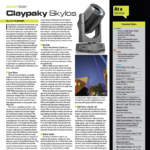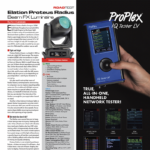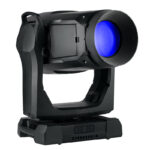RC4 Wireless is a company that focuses on a small segment of products consisting of wireless dimming and control. I had the opportunity to review their complete Series 3 wireless system earlier this year, and was really impressed with the product’s feature-set and power in doing such seemingly simple things as improving the ability to wirelessly control and dim lighting devices of all sizes.
When they reached out with a new device in the family aimed at bringing their expertise to controlling LED tape more effectively and efficiently, I was very intrigued (especially after doing the LED Tape Shootout for PLSN’s sister publication, StageDirections, a few months back). Their RC4Magic DMXpix is designed to be a versatile, wireless, powerful LED pixel driver that conquers two of the major problems affecting anyone who deals with LED pixel tape today: Obscene channel count requirements and variations in color.
Looking at the Device
Comprised of a small black box barely bigger than an average thumb drive, the DMXpix has two outputs for LED tape, a port for DMX output (via RC4 mini-plug to XLR adapter cable) and an I2C port for interfacing with Arduino, Raspberry Pi or other types of microcontrollers. The user interface on the DMXpix itself is entirely based on three tiny recessed buttons on the side of the unit that are activated via RC4’s provided tool, or via paper clip (which RC4’s tool is a sturdier version of). This will be familiar to users of other RC4 products, and is how they are able to make their devices so incredibly small, but might frustrate new users. Have patience, though — their documentation is stupendous, and you won’t need to memorize all the button combinations, just a few important ones. All of the configurable options of the DMXpix (and every other RC4 device) are also easily accessed via their RC4MagicPC application, and this is my preferred way of configuration for RC4 systems.
 One great feature of RC4 devices is that they give each user and project their own set of three separate, unique digital IDs. Devices on one ID will never communicate with devices on a different ID. The other system could be one of yours, or it could belong to someone else. In any case, interference just can’t happen. This means you could have multiple separate RC4 systems functioning independently of each other in one installation, controlled totally separately without interfering with each other. After configuring the ID of your system and establishing communication with the DMXpix device, all the settings of the unit are accessible. When using RC4MagicPC to configure devices, users can use a USB dongle (or a DMXio unit with CodeLoader USB to mini-plug adapter) to access the settings in a nice concise PC interface — otherwise all configuration can be done via a combination of DMX and button manipulation.
One great feature of RC4 devices is that they give each user and project their own set of three separate, unique digital IDs. Devices on one ID will never communicate with devices on a different ID. The other system could be one of yours, or it could belong to someone else. In any case, interference just can’t happen. This means you could have multiple separate RC4 systems functioning independently of each other in one installation, controlled totally separately without interfering with each other. After configuring the ID of your system and establishing communication with the DMXpix device, all the settings of the unit are accessible. When using RC4MagicPC to configure devices, users can use a USB dongle (or a DMXio unit with CodeLoader USB to mini-plug adapter) to access the settings in a nice concise PC interface — otherwise all configuration can be done via a combination of DMX and button manipulation.
Tale of the Tape
I have a healthy amount of experience with LED tape and the headache it can cause in installations. From the number of pixels, the order those pixels are laid out in (RGB, BGR, GRB…the list goes on), to each tape’s particular white point (or lack thereof), using LED tape to achieve a desirable outcome can be a massive headache. This is where the DMXpix shines and, as such, it is a fantastic replacement for most LED drivers I’ve seen before.

In the DMXpix configuration window in RC4MagicPC, one is able to see all the parameters available: type of LED tape, order of colors in the string, DMX addressing options, and ColorMatch settings. You are able to choose from one of several of the popular LED tape flavors on the market currently: APA102, LPD8806, and WS28xx. The ability to change order of colors in the string to match your expected DMX channel layout is fantastic — this is an issue that has driven me to create dozens of custom profiles in consoles and media servers just to get the colors to line up correctly. By setting the color order in the DMXpix, DMX channel order is as expected across all tapes used: RGB on channels 1,2,3.

You’re also able to set the starting DMX address of the LED tape strip on each DMXpix port, as well as how many pixels you want controlled directly, referred to as their “Custom Pixel Profiles.” This is an interesting feature, and the heart of the DMXpix. It allows you to bypass pixel-per-pixel control (which can easily swallow entire universes of DMX after just a few meters of LED tape) in favor of controlling “key frames,” or patterns of illumination you want to repeat along the tape, and lets you dictate how those patterns repeat, so you can create massive effects in a very DMX-economical way. This is helpful even on large desks — and a lifesaver on smaller lighting consoles.
With the custom pixel profiles feature of the DMXpix the user has three parameters to set: Sequence Length — how many channels of console control desired; Sequence Mode — how the LED tape should reflect and replicate patterns down the string; and Group Length — how many pixels in series on the tape will be controlled by one control pixel on the console. By manipulating these parameters, users can really dig into creating LED tape effects with varying degrees of symmetry and granularity of control. At its simplest, one could control one 60-pixel length of RGB tape in 10-pixel sections to cut down on DMX footprint, going from 180 channels of control to 30 channels, or even fewer. To make things more powerful, one could expand control of a strip of LED tape by grouping three pixels together to allow control of up to 500 pixels of RGB LEDs from a standard universe of DMX, allowing triple the length of pixels usually possible. Being someone very into pixel mapping and LED installations, this is a super powerful feature once you get your head around it. It does take some playing with, but the RC4MagicPC application makes this intuitive. By experimenting with different lengths of sequence and groups, I was able to create appealing effects with minimal programming and even less DMX channel footprint, and the different modes of repetition made it easy to get different kinds of symmetry.


Another great fixture of the DMXpix — which I absolutely loved — is its ColorMatch feature. ColorMatch allows you to set a custom white point for each LED tape output on each DMXpix. Hark, the herald angels sing! Unified color mixing across a plethora of LED tape product! In all seriousness, this feature is extremely powerful, and an absolute life- and time-saver in LED tape installations. Using the virtual transmit function of RC4MagicPC or your lighting console itself, the custom white point values (as well as all other settings) can be saved and then pushed to other DMXpix devices, making configuration of a lot of product quick and easy. RC4 says that future implementations will allow saving/loading of custom settings profiles via XML, as well. A five minute test of this left me extremely impressed, as I was able to quickly match two vastly different “white” points to an actual level that resembles true white in both tapes. Once configured with ColorMatch and other settings, lighting console and media server programming can take place without the huge time sink of correcting all these issues on the control side.
The DMXpix is a well-done product from RC4, and a great addition to their range of wireless control products. I liked that configuration could take place either directly from DMX and tactile input, or from their RC4MagicPC application, and the feature-set provided is a very strong toolkit for designers, programmers, and integrators working with LED tape products. Be sure to check it out!
At a Glance
Tame the Tape Monster
Anyone acquainted with LED pixel tape these days is also undoubtedly familiar with two major challenges: huge channel count requirements and lack of consistency in color. RC4 Wireless’ DMXpix LED pixel controller’s utility starts with the ability to deal with varying LED tape pixel layouts (i.e., RGB, BGR, GRB, etc.), with a long string of benefits extending from there.
RC4Magic DMXpix
PROS
Impressive DMX channel savings for LED tape; granular control over LED tape parameters; color match technology synchronizes LED colors.
CONS
Tiny, tiny buttons
KEY BENEFITS
RC4 Wireless lets users manipulate LED pixels in organized groups rather than on an LED-by-LED basis. Along with Custom Pixel Profiles and Key Frames, users can adjust Sequence Length, Sequence Mode and Group Length parameters, and, at its simplest, group three pixels together for an easy (and dramatic) reduction in channel count requirements.
DMXpix’s ColorMatch, meanwhile, lets users set a custom white point for unified color mixing — trimming the time normally spent color-correcting these issues via console tweaks.
SPECS
Size: 61 x 36 x 20mm
MSRP: $399
Manufacturer: RC4 Wireless
More Info: www.theatrewireless.com



